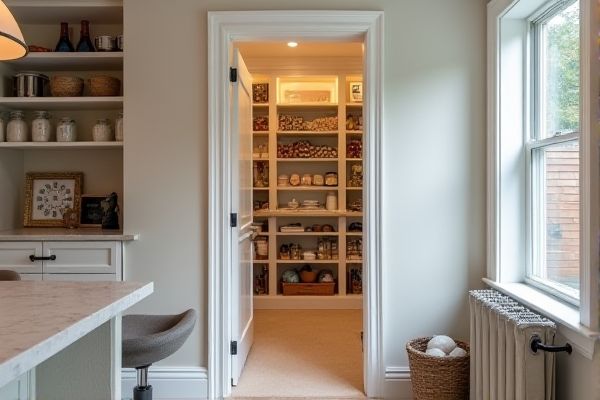
Reach-in pantries offer compact storage solutions ideal for kitchens with limited space, using shelves and organizers to maximize accessibility within a shallow closet area. Your choice between a reach-in pantry and a walk-in pantry depends on kitchen size and storage needs; read on to discover which option best suits your home and lifestyle.
Table of Comparison
| Feature | Reach-In Pantry | Walk-In Pantry |
|---|---|---|
| Size | Small to medium, typically 3-6 feet wide | Large, usually 6+ feet wide and deep enough to walk inside |
| Storage Capacity | Limited shelf space, ideal for frequently used items | Extensive shelving for bulk storage and large containers |
| Accessibility | Open shelving reachable from doorway | Walk-in space allows access to all sides, easier organization |
| Installation Cost | Lower cost due to smaller size | Higher cost, requires more space and construction |
| Use as Closet | Limited space for clothing or non-food storage | Spacious enough to use as a multi-purpose storage or closet |
| Ideal For | Small kitchens, limited space scenarios | Large kitchens, homes needing extensive storage |
Introduction: Understanding Pantry Types
Reach-in pantries maximize compact storage with shallow shelves that optimize small or narrow spaces, ideal for quick access to frequently used items. Walk-in pantries function as dedicated rooms or closets with deep shelving and ample floor space, allowing for extensive organization and bulk storage of groceries and kitchen supplies. Both pantry types enhance kitchen efficiency, but choice depends on available space and user needs for accessibility versus capacity.
Space Efficiency: Reach-in vs Walk-in Pantries
Reach-in pantries optimize smaller kitchen areas by utilizing vertical storage with adjustable shelves, making them ideal for compact spaces and easy access to frequently used items. Walk-in pantries offer expansive storage capacity with multiple shelving options, enabling organized storage of bulk goods and appliances but require a larger footprint. Choosing between reach-in and walk-in pantries depends on the available kitchen space and the need for either compact organization or extensive storage flexibility.
Storage Capacity Comparison
A walk-in pantry offers significantly greater storage capacity compared to a reach-in pantry, providing ample room for bulk items, large kitchen appliances, and custom shelving tailored to your needs. Reach-in pantries are more compact and better suited for smaller kitchens or limited spaces, but they typically accommodate fewer items with narrower shelves. Your choice depends on available square footage and the volume of groceries and kitchen essentials you need to organize efficiently.
Accessibility and Organization
Reach-in pantries offer easy access to frequently used items with shelves designed for quick retrieval, while walk-in pantries provide ample space for comprehensive storage and more elaborate organization systems such as built-in cabinets and adjustable shelving. Reach-in pantries optimize vertical space for visibility but may require careful stacking to prevent clutter, whereas walk-in pantries accommodate bulkier items and multiple users simultaneously, enhancing overall functionality. Maximizing accessibility and organization depends on the pantry size and usage frequency, with walk-ins favored for larger kitchens seeking customizable storage solutions.
Closet Conversion: Transforming Spaces
Closet conversion for pantry use involves optimizing existing reach-in pantry spaces into more functional storage by adding adjustable shelving and organizational accessories. Walk-in pantry conversions maximize space by creating custom cabinetry, lighting, and ventilation to enhance accessibility and food preservation. Both approaches improve kitchen efficiency by transforming underutilized closet areas into dedicated, organized food storage zones.
Cost Implications and Budget Considerations
Reach-in pantries offer a more budget-friendly option due to their smaller size and simpler construction, typically costing between $500 and $2,000 depending on materials and finishes. Walk-in pantries, with their larger space and custom shelving, commonly range from $2,000 to $10,000 or more, reflecting higher labor and design expenses. Homeowners aiming to maximize storage while minimizing costs often prefer reach-in pantries, whereas those with flexible budgets seeking extensive storage customization may invest in walk-in pantry closets.
Design Flexibility and Customization
Walk-in pantries offer greater design flexibility, allowing you to customize shelving, drawers, and compartments to fit large appliances and multiple storage needs. Reach-in pantries, typically narrower, require more compact and efficient organization solutions, like adjustable shelves and pull-out baskets, to maximize limited space. Your choice depends on available room and preference for tailored storage versus streamlined accessibility.
Maintenance and Upkeep Differences
Reach-in pantries require minimal maintenance due to their smaller size, making it easier to clean shelves and organize items regularly. Walk-in pantries demand more upkeep to manage larger storage spaces, including deep cleaning floors and ensuring proper ventilation to prevent moisture buildup. Your choice affects the time and effort needed for routine maintenance and organization.
Best Uses for Reach-in vs Walk-in Pantries
Reach-in pantries are ideal for smaller kitchens or limited spaces, offering convenient access to frequently used items stored on shelves or in cabinets. Walk-in pantries provide ample room for bulk storage, larger appliances, and organized sections, making them suitable for families needing extensive food and kitchen supply storage. Your choice depends on the available space and how much storage capacity you require for efficient kitchen organization.
Choosing the Right Pantry for Your Home
Choosing the right pantry for your home depends on your available space and storage needs. A reach-in pantry offers quick access and works well in smaller kitchens, while a walk-in pantry provides expansive storage and organization options, ideal for larger homes or frequent bulk shoppers. Your choice should balance convenience, storage capacity, and kitchen layout to optimize functionality.
 homyna.com
homyna.com